This post contains affiliate links.
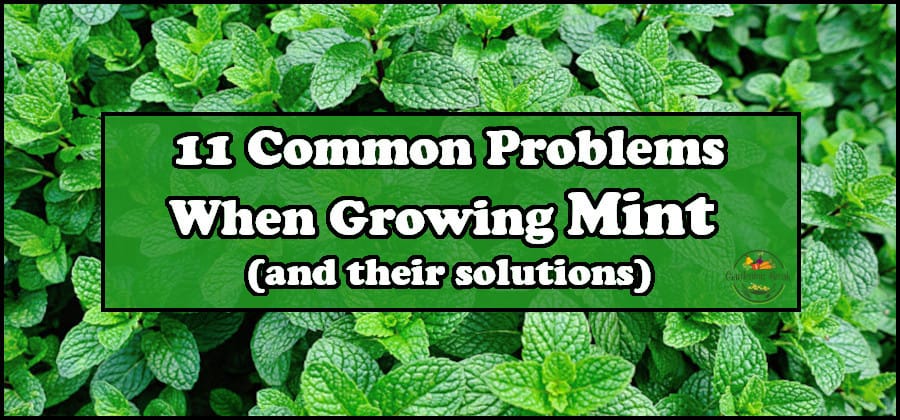
Mint is one of the most popular herbs to grow at home. It tastes good, smells good, and is fun to grow, but there are also quite a few potential problems you can run into when growing mint.
If you are growing mint and have run into some problems, this article is for you. Just scroll until you find the headline that describes your problem to see what do to.
As you will see in the photos in this article, I have had my share of problems with mint plants, but I have also figured out how to solve them, either by talking to experts, reading books and online material, or just testing for myself.
In this article, I share everything I have learned about 11 of the most common problems people run into when growing mint and, most importantly, how to solve them.
1. Leggy and Thin or Stretching Mint Plants (What to Do)
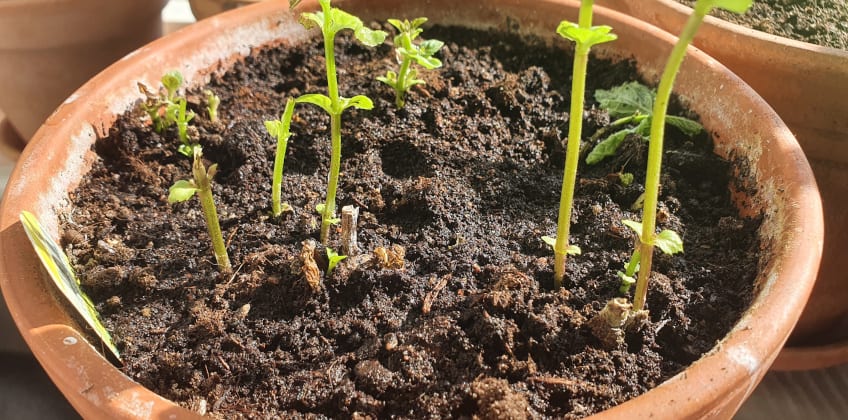
A very common problem people run into when growing mint is that their plants stretch and become long, thin, and leggy instead of dense and bushy. This affects how nice the plants look, but more importantly, it greatly affects how much you can harvest from them.
The most common reasons for mint plants being thin and leggy instead of dense and bushy are lack of sunlight, heat, water, or nutrients, although too much fertilizer can also be a reason.
Mint is a versatile plant that can grow in many environments. It doesn’t need a lot of sunlight to grow, but you should know that mint plants that grow in colder environments without much sunlight will generally become a lot more leggy or scraggly than if they were grown in a warm and sunny environment.
Solution:
The best way to stop mint plants from stretching and becoming leggy is to increase the amount of sunlight they get. Other things that can help include moving the plant to a warmer spot and growing it in well-drained, nutrient-rich soil in a large pot while watering it when the top of the soil is dry.
If you want your mint plant to become bushier and more productive, I really recommend reading this article, where I cover 8 tips for exactly that.
2. Mint Spreading and Getting Out of Control (What to Do)
Unlike a lot of other herbs, mint spreads horizontally through so-called runners. This can definitely be a good thing as it allows you to get a lot more mint with minimal effort, but it can certainly also be a problem if it gets out of control.
Unfortunately, the best way to deal with mint spreading is to be proactive and prevent it before it happens. The best method is to plant it in a regular pot, but another method is to plant it in a bottomless pot that is put in the ground except for a few inches above the ground to prevent spreading.
The bottomless-pot method is also a way you can grow multiple mint varieties near each other without having them mix. I have another article about that here.
If the damage has already happened and your mint is out of control and taking over parts of your garden it shouldn’t, there is something you can do but I’m afraid it is going to take time and effort.
Solution:
The best way to get rid of an invasive mint plant is to physically remove the whole plant, including the roots. Boiling water or a mixture of salt, soap, and vinegar can also be used to kill milt, although it only kills the parts it comes in contact with.
The easiest way to remove an invasive mint is to use a good shovel and get to work. Make sure to dig deep and get rid of the entire root system as it can otherwise grow back over time.
3. White Spots on Mint Plant’s Leaves (What to Do)
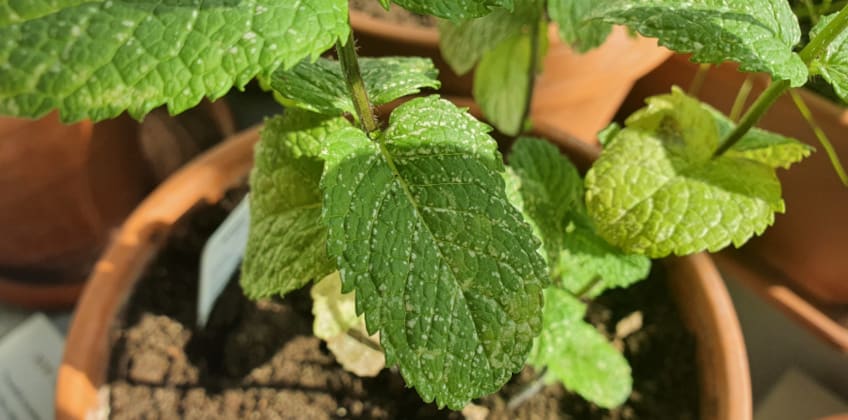
I recently noticed that one of my mint plants started getting small white spots all over its leaves even though it had looked perfectly healthy until then. This is very common, and if your mint looks similar to mine in the photo above, you should read this.
When I first noticed this problem, I snapped a few photos and drove to a nearby plant nursery where I showed them to one of their full-time gardeners. He almost immediately told me that it was most likely caused by insects.
I know for a fact that there were some tiny insects on my mint plant when it had this problem. I’m pretty sure they were either aphids or thrips (or both), although I am not 100% sure. What I am 100% sure of, however, is that the trick the expert gardener from the nursery taught me worked extremely well for my mint.
Solution:
The best way to save a mint plant that is being attacked by insects such as aphids or thrips is to sink the whole plant into a bucket full of water mixed with a natural liquid soap or neem oil. Keep the whole plant submerged until no more bubbles come up and then take it out.
A lot of people also recommend misting plants with neem oil and report really good results. They didn’t have that at the nursery I went to though, so I just used the method with natural soap and it worked great.
If your mint is in the ground, you obviously can’t sink it into water. In that case, you should use the neem oil or the soap mix to water the soil around the plant well as well as spray it all over the plant.
4. Wilting or Drooping Mint Plants (What to Do)
Wilting plants is one of the most common problems mint growers run into. Wilting, also sometimes called drooping, is when a plant’s leaves begin to hang loose and get soft and fold. There are several things that can cause plants to wilt.
Wilting actually works to reduce water loss as it reduces the overall surface area of the leaves that are exposed to the sun’s evaporative rays. You can read more about that in this article from Britannica.
The most common reason why mint plants wilt is lack of water, but overwatering can also cause it to happen. So you need to find the balance. I will help you do that.
Solution:
The best way to keep a mint plant from wilting is to make sure it is being watered properly. Mint grows best in soil that is consistently moist and never dry or soaking wet, as both of those can cause it to wilt. Water mint when the top of the soil is dry to touch but don’t let it dry up completely.
While wrong watering is probably the primary cause of wilting mint plants, other growing conditions such as sunlight and temperature also play a role, so make sure your mint has the right growing conditions. I have written this post to help you with that.
5. Burned or Scorched Mint Leaves or Stems (What to Do)
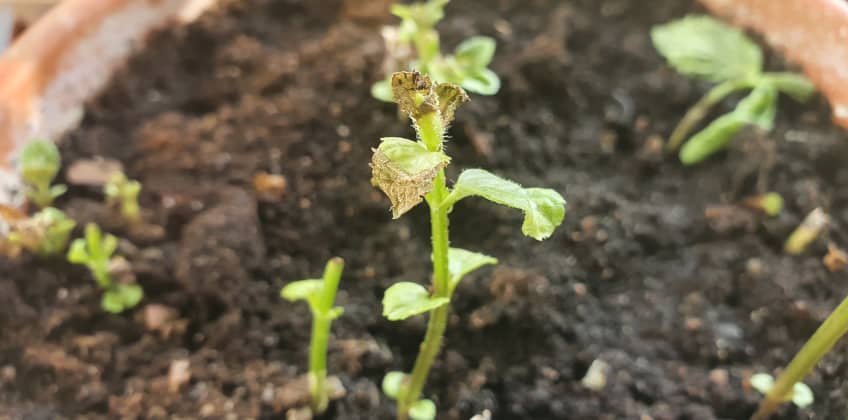
If some of the leaves on your mint plant look like they have been burned or scorched, there is a high chance it is being exposed to very intense sunlight for too long.
Mint usually grows very well in full sun, but if you live somewhere where the sunlight can be very intense for a long time, it can become a bit too much for your mint.
Sun damage will typically happen to the leaves near or at the top of the plant since they are most exposed to sunlight. Luckily, the solution is pretty simple.
Solution:
When some of the leaves at the top of a mint plant look burnt or scorched, the best way to save the plant is to move it to a spot where it is exposed to less direct sun, although it should still get some. Cut the affected stems and leaves off the plant to promote new, healthy growth.
When you cut stems from your mint, is it best to use clean, sharp pruning shears to avoid damaging the plant and reduce the risk of pests and diseases attacking it.
6. Mold or Mildew on Mint Plants or Soil (What to Do)
Mold or mildew can, and often does, affect most types of garden plants, including mint. When it happens, it is best to act fast to prevent it from spreading too much.
The most common reasons why mint plants get mold are too high humidity or too wet soil, for example, because of overwatering. Poor airflow can also lead to mold, so make sure your mint has air all the way around it.
Mold or mildew can appear on plants in many different forms and can occur both on the soil the plant is growing in and on the plant itself.
Solution:
If there is mold or mildew on parts of your mint plant, remove those parts as soon as possible. If there is mold on the plant’s soil, gently scrape it off with a spoon or move the plant to another pot if there is too much. Make sure you remove all potentially affected parts of the plant to prevent it from spreading.
If there is mold on your mint plant or on its soil, there is a good chance you are overwatering it. If the soil is dry or just lightly moist, overwatering is most likely not the problem, but if the soil is completely wet, you are probably overwatering it. If that is the case, you should read this article where I explain how to tell if overwatering is the issue and how to save your plant.
7. Slow or Stunted Growth in Mint Plants (What to Do)
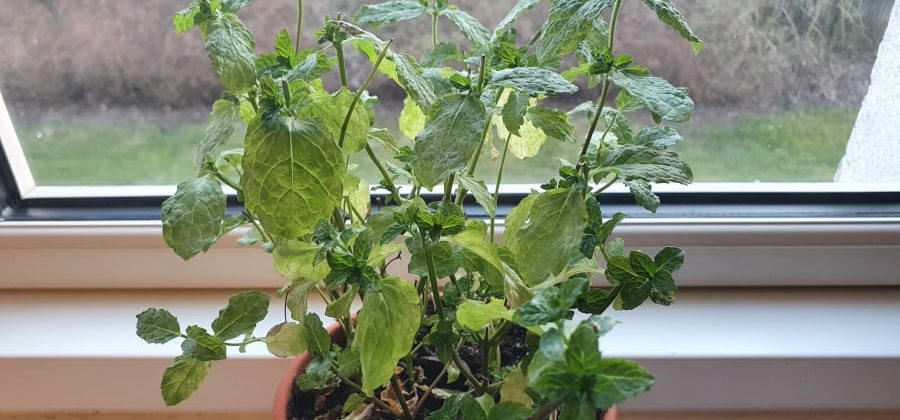
There are many things that can cause stunted or slowed growth in mint plants, but the truth is that it is almost always caused by one or a few specific things.
The thing that most commonly causes mint plants to stop growing is that they run out of space. Mint plants spread rapidly, so if they have limited space and room for the roots, they eventually run out. When that happens, the plant will stop growing as it can’t obtain water and nutrients properly.
When a mint plant’s root system grows so much that it fills up the pot and the plant can’t obtain water and nutrients properly, the leaves will often begin to lose color and become lighter green or even yellow. That is precisely what happened to one of my mint plants which you can see in the photo above.
While this is the most common reason, stunted growth in mint can also be caused by other issues such as overwatering, overfertilizing, or poor growing conditions. Therefore, I recommend reading this article where I cover 5 reasons for mint growing slowly and how you can speed it up.
You should keep in mind that mint plants usually stop growing or grow slower when it is cold in the winter. If that is not the situation you are in, chances are your plant needs some more space.
Mint also grows a lot slower when it is flowering. If your mint is flowering, I recommend reading this article if you are not sure what to do.
When a plant’s roots grow so large that there is no room left in the pot, the plant becomes rootbound. This is a problem as it greatly inhibits the plant’s ability to grow. Luckily, it is not that hard to fix.
Solution:
The best way to save a rootbound mint plant is to transplant it to a bigger pot with more room for its roots. For large mint plants, it is a good idea to split the plant into two or more parts and plant each of them in separate pots.
If you need to split your mint into more parts before transplanting it, take it out of the pot and just cut through it vertically, either with a pruning saw or just a pair of pruning shears. Try to split the plant without cutting through too many roots but know that is it necessary to cut some and that your plant will be fine. Try to keep as much soil on the roots as possible, as that will make the transition to another pot easier for the plant.
8. Orange or Rust-Colored Spots on Mint Leaves (What to Do)
If there are orange or rust-colored spots on your mint plant’s leaves, there is a very high chance that it is mint rust. If that is the case, you need to act fast to prevent it from spreading or getting into the soil.
Mint rust is a fungal disease that infects most mint varieties as well as a few other plants such as marjoram and savory.
Don’t wait around for things to solve themselves if your mint has mint rust because they won’t, but instead get worse and worse.
Solution:
According to The Royal Horticulture Society, the best way to control mint rust is to remove any affected plants promptly before the spores spread and contaminate the soil. There are no fungicides available to gardeners to treat mint rust, according to RHS.
9. Most Common Pests That Attack Mint Plants (What to Do)
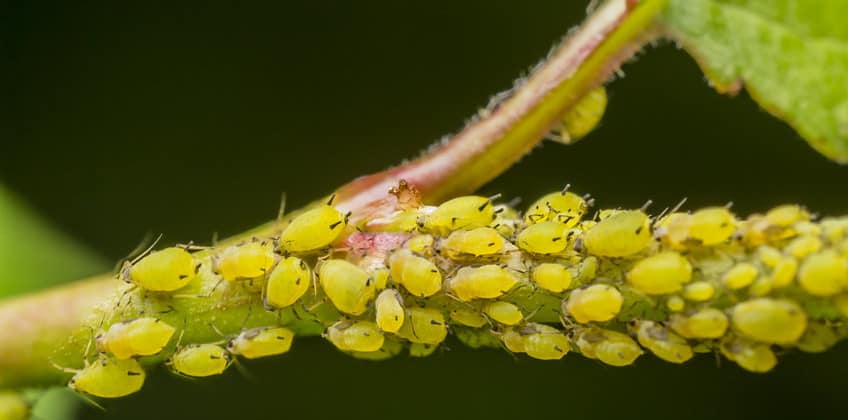
One of the most common causes of problems with mint plants is that they get attacked by pests.
You can grow mint both indoors and outside and in a pot and in the ground. Potted mint is slightly less at risk of being targeted by pests than mint growing in the ground and mint growing indoors is, of course, a lot less at risk than mint growing outside.
According to PlantVillage, the most common pests that attack mint plants include aphids, thrips, and spider mites.
I had a lot of aphids and thrips (i think) on two of my mint plants recently, so one day, when I was at a nearby plant nursery anyway, I asked one of the experts there if he had a tip, and he sure did.
Solution:
The easiest way to get rid of small pests such as aphids and thrips that are on a mint plant is to submerge the whole plant, including the pot into a mix of water and natural, liquid soap until no more bubbles come up. For mint growing in the ground, use the mixture to spray it and water the soil thoroughly.
For larger pests, it is sometimes easier to simply flick them off the plant when you see them. Alternatively, you can also spray them with the mix. I have also read about a lot of people who had success getting rid of pests by using neem oil, but the nursery I was at didn’t have that, so I haven’t tried it myself.
10. Mint Plant’s Soil Doesn’t Dry Out Properly (What to Do)
If the soil your mint is growing in never really dries out properly, chances are you are overwatering it, even if it seems like you aren’t.
Overwatering mint is a very common problem since some of the signs could also seem like the plant is getting too little water, which often makes people water it even more, even though too much water is the problem in the first place.
The most reliable way to tell if a mint plant is being overwatered is to check the soil. If it stays wet for several days without being watered, your plant is most likely overwatered.
If plants are being overwatered for a while, their roots will begin to rot and when that happens, the plant can’t obtain water and nutrients properly, which causes them to die over time.
I have written another article to help you identify if overwatering is the problem and, if so, how to solve it. I also cover the essential things you should know here, though.
Solution:
To save an overwatered mint plant, place it in a sunny spot, remove the plate from underneath it, and stop watering it until the top inch of the soil is dry. For severe cases of overwatering, it is often necessary to transplant the affected plant to a new pot with a lot of new soil.
You should also remove any dead growth from your affected mint plant as it can attract diseases.
Unfortunately, if the plant is severely damaged by overwatering, it can be too late to save it. In that case, I recommend that you take some cuttings from the plant, root them in water for a few weeks, and then plant them in soil as new plants, once they have grown roots. That way, you can at least continue to grow the same mint plant, although it will take some time for it to grow big.
11. Mint Leaves Turning Yellow or Brown (What to Do)
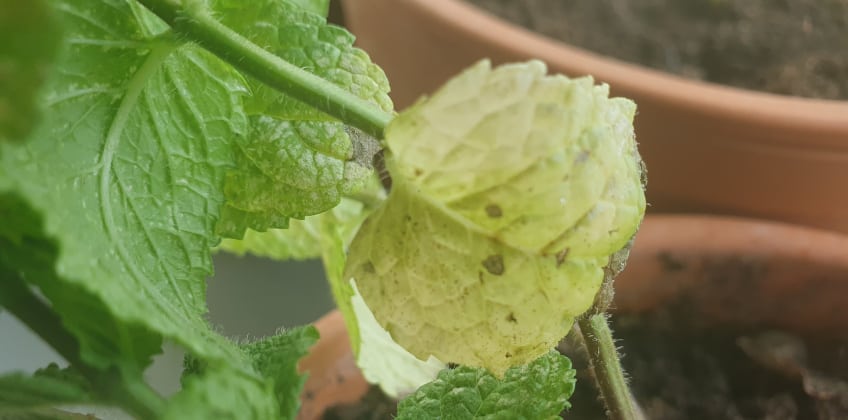
It is very common for some of the leaves on a mint plant to turn yellow or even brown over time. It is usually just a natural part of the process that happens to some of the lower, older leaves. That said, it can also be caused by a number of problems, especially if it happens to new leaves, so keep reading.
The most common reason why mint plants and especially the leaves begin to turn yellow or brown is lack of nutrients. However, there are also other potential reasons, such as lack of sunlight, overwatering, overfertilizing, or lack of space.
Solution:
Mint becomes darker green, looks fresher, and generally just grows better in well-drained, nutrient-rich soil in full or partial sun and when it is watered whenever the top of the soil is dry. Without these conditions, some of the leaves will likely start yellowing and eventually fall off.
Another thing that actually plays a big role is that mint needs a fair amount of growing space to really thrive. That’s why I recommend using a large pot for it.
There is more to keep in mind than size when picking a pot, however. The material also affects how well the plant grows since some materials allow for better drainage and oxygenation than other materials. I recommend reading this article if you are looking for a good pot for your mint or if you just want to know something about good plant pots in general.

